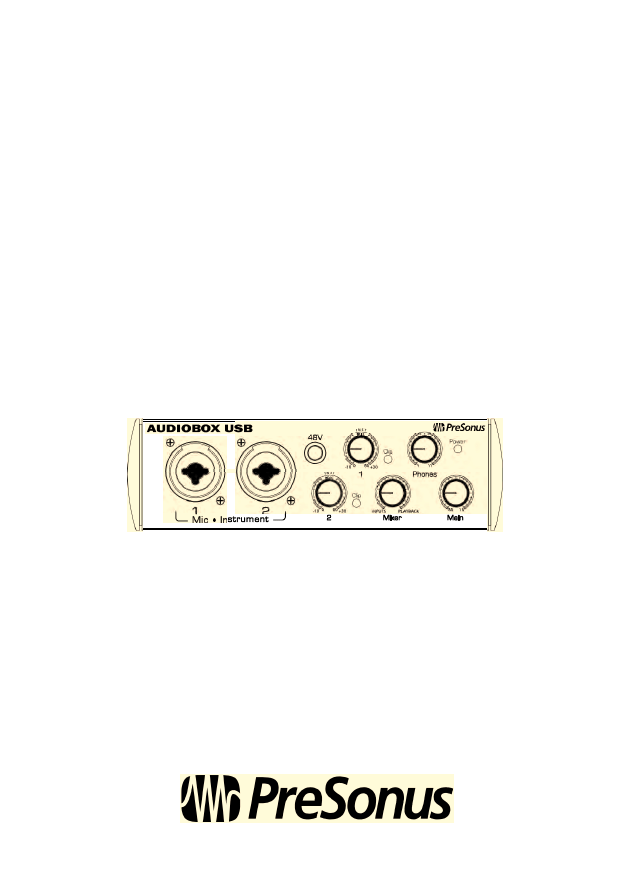
© 2009, PreSonus Audio Electronics, Inc.
AudioBox USB
24bit/48k Recording Interface
User’s Manual
Version 2.0
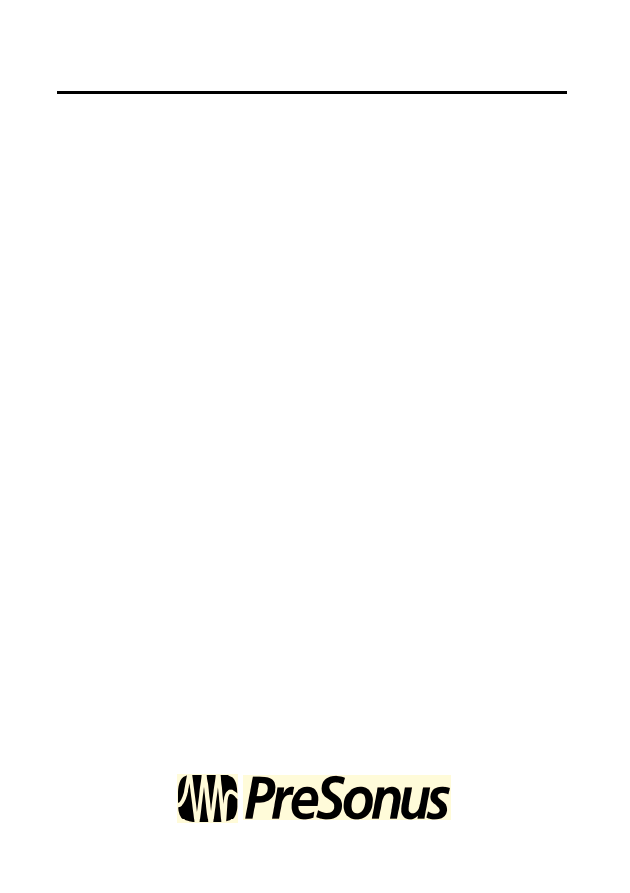
PRESONUS LIMITED
WARRANTY
© 2009, PreSonus Audio Electronics, Inc.
PreSonus Audio Electronics Inc. warrants this product to be free of defects in material and
workmanship for a period of one year from the date of original retail purchase. This warranty is
enforceable only by the original retail purchaser. To be protected by this warranty, the purchaser
must complete and return the enclosed warranty card within 14 days of purchase. During the
warranty period PreSonus shall, at its sole and absolute option, either repair or replace, free of
charge, any product that proves to be defective on inspection by PreSonus or its authorized service
representative. To obtain warranty service, the purchaser must first call or write PreSonus at the
address and telephone number printed below to obtain a Return Authorization Number and
instructions of where to return the unit for service. All inquiries must be accompanied by a
description of the problem. All authorized returns must be sent to the PreSonus repair facility
postage prepaid, insured and properly packaged. PreSonus reserves the right to update any unit
returned for repair. PreSonus reserves the right to change or improve the design of the product at
any time without prior notice. This warranty does not cover claims for damage due to abuse, neglect,
alteration or attempted repair by unauthorized personnel, and is limited to failures arising during
normal use that are due to defects in material or workmanship in the product. Any implied
warranties, including implied warranties of merchantability and fitness for a particular purpose, are
limited in duration to the length of this limited warranty. Some states do not allow limitations on
how long an implied warranty lasts, so the above limitation may not apply to you. In no event will
PreSonus be liable for incidental, consequential or other damages resulting from the breach of any
express or implied warranty, including, among other things, damage to property, damage based on
inconvenience or on loss of use of the product, and, to the extent permitted by law, damages for
personal injury. Some states do not allow the exclusion of limitation of incidental or consequential
damages, so the above limitation or exclusion may not apply to you. This warranty gives you specific
legal rights, and you may also have other rights, which vary from state to state. This warranty only
applies to products sold and used in the United States of America. For warranty information in all
other countries please refer to your local distributor.
PreSonus Audio Electronics, Inc.
7257 Florida Blvd.
Baton Rouge, LA 70806
www.PreSonus.com

TABLE OF CONTENTS
1 OVERVIEW
1.1 Introduction ................................................................................ 3
1.2 Features ..................................................................................... 4
1.3 What is in the Box ...................................................................... 5
1.4 System Requirements .................................................................. 6
2 GETTING STARTED
2.1 Hardware Installation ................................................................. 7
2.1.1 Installation in Mac OSX ................................................... 7
2.1.2 Installation in Windows .................................................... 7
2.2 Studio One Artist ........................................................................ 9
2.2.1 Installation and Authorization .......................................... 9
2.2.2 Enabling the Audio Driver .................................................11
2.2.3 Configuring Your MIDI Devices.........................................12
2.2.4 Configuring Audio I/O .......................................................15
2.2.5 Creating a Dong................................................................17
2.3 Sample Hookup Diagram .............................................................20
2.4 Microphones ...............................................................................21
2.4.1 Condenser ........................................................................21
2.4.2 Dynamic ..........................................................................21
2.4.3 USB and other types ........................................................22
3 HARDWARE OVERVIEW
3.1 Front Panel Layout .....................................................................23
3.2 Back Panel Layout ......................................................................25
4 TECHNICAL INFORMATION
4.1 Specifications .............................................................................26
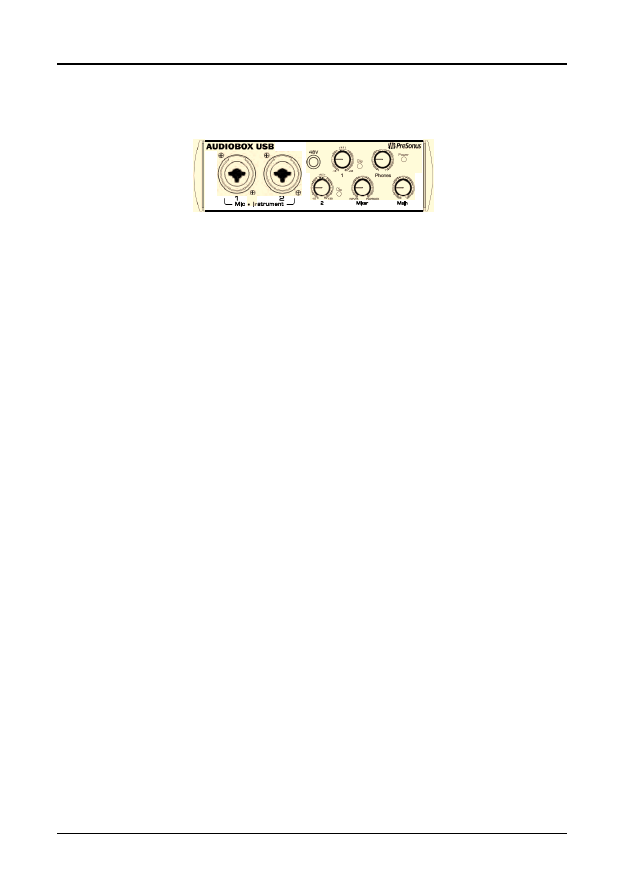
OVERVIEW
3 | PreSonus 2008
1.1 INTRODUCTION
Thank you for purchasing the PreSonus AudioBox USB. PreSonus Audio Electronics has designed
the AudioBox USB utilizing highgrade components to ensure optimum performance that will last a
lifetime. Loaded with 24bit 48kHz converters, two PreSonus microphone preamplifiers and Cubase
LE 48track music production software, the AudioBox USB is ready to go out of the box for
professional quality computer recording. All you need is a computer with USB connection, a couple
of microphones and cables along with your instruments and you are ready to record!
We encourage you to contact us at 2252167887 or techsupport@presonus.com with any questions
or comments you may have regarding your AudioBox USB. PreSonus Audio Electronics is
committed to constant product improvement, and we value your suggestions highly. We believe the
best way to achieve our goal of constant product improvement is by listening to the real
experts
, our
valued customers. We appreciate the support you have shown us through the purchase of this
product.
We suggest you use this manual to familiarize yourself with the features, applications and correct
connection procedure for your AudioBox USB before trying to connect it to your computer. This will
hopefully alleviate any unforeseen issues that you may encounter during installation and set up.
Thank you, once again, for buying our product, and we hope you enjoy your AudioBox USB!

OVERVIEW
4 | PreSonus 2008
1.2 FEATURES
The AudioBox USB is a powerful and affordable computer recording system complete with everything
needed for realworld recording applications. The AudioBox USB comes complete with two high
quality PreSonus microphone preamps, MIDI I/O, rock solid drivers, as well as a PreSonus Studio
One Artist music recording and production software.
Summary of features
• 24bit / 48k USB audio recording interface
• 2 class A XMAX microphone / instrument preamplifiers
• 48V phantom power
• 2 balanced TRS outputs
• MIDI
input/output
• Powered via USB
All PreSonus audio interfaces now include PreSonus Studio One Artist recording software, which
comes with over 4 GB of plugins, loops, and samples, giving you everything you need for music
recording and production.
Summary of features
• Unlimited track count, inserts and sends
• 20 highquality native effects plugins
• Amp Modeling (Ampire)
• Delay (Beat Delay)
• Distortion (Redlight Distortion)
• Dynamic Processing (Channel Strip, Compressor, Limiter, Tricomp)
• Equalizer (Channel Strip, Pro EQ)
• Modulation (Autofilter, Chorus, Flange, Phaser, XTrem)
• Reverbs (MixVerb, Room Reverb)
• Utility (Binaural Pan, Mixtool, Phase Meter, Spectrum Meter, Tuner)
• Over 4 GB of loops, samples, and instruments, featuring:
• Presence: Virtual Sample Player
• Impact: Virtual Drum Machine
• SampleOne: Virtual Sampler
• Mojito: Virtual AnalogModeled Subtractive Synthesizer
• Innovative and intuitive MIDI mapping
• Powerful draganddrop functionality for faster workflow
• Mac OS X and Windows compatible
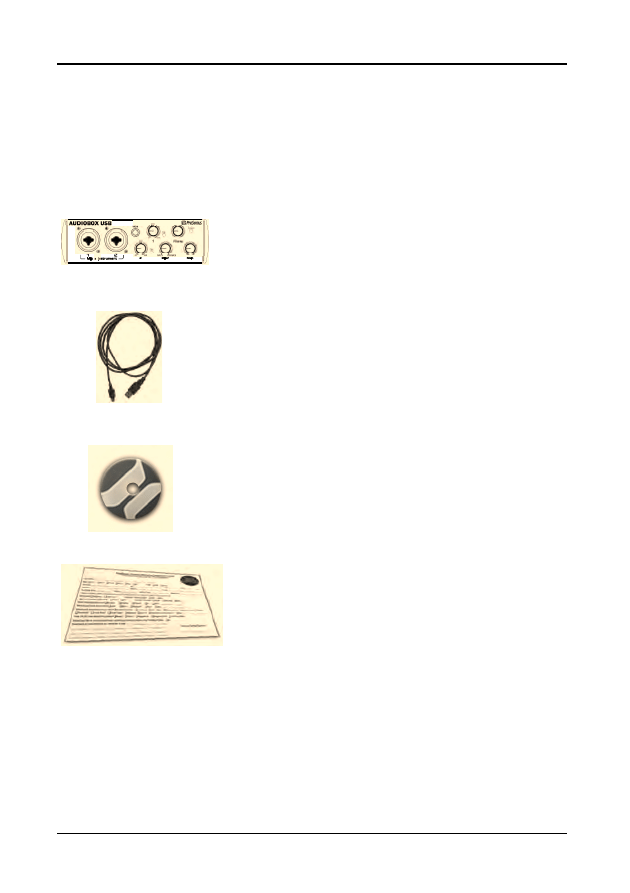
OVERVIEW
5 | PreSonus 2008
1.3 WHAT IS IN THE BOX
Your AudioBox USB package contains the following:
•
AudioBox USB
•
6’ USB Cable
•
Software installation discs:
o
PreSonus AudioBox USB Driver
Installation Disc
o
Studio One Artist Installation DVD
•
PreSonus Warranty Card

OVERVIEW
6 | PreSonus 2008
1.4 SYSTEM REQUIREMENTS
Below are the minimum computer system requirements for your AudioBox USB and Studio One
Artist.
Macintosh
o
Mac OS X 10.4.11 or Mac OS X 10.5.2 or higher
o
Minimum Hardware:
•
PowerPC G4 1.25 GHz or Intel Core Solo 1.5 GHz processor
•
1 GB RAM
•
DVD drive
Recommended:
•
PowerPC G5 or better or Intel Core Duo or Intel Xeon processor or better
•
2 GB or more RAM
•
DVD drive
Windows PC
o
Windows XP SP2 or later or Vista (32bit only)
o
Minimum Hardware:
•
Intel Pentium 4 1.6 GHz processor or AMD Athlon 64 (Turion)
•
1 GB RAM
•
DVD drive
Recommended:
•
Intel Pentium 4 2.8 GHz EM64T or better or AMD Athlon 64 3000+ or better
•
2 GB or more RAM
•
DVD drive
NOTE: The speed of your processor, amount of RAM, and size and speed of your hard drives greatly
affect the overall performance of your recording system. A more powerful system (faster processor
with more RAM) allows for lower latency (signal delay) and better overall performance.
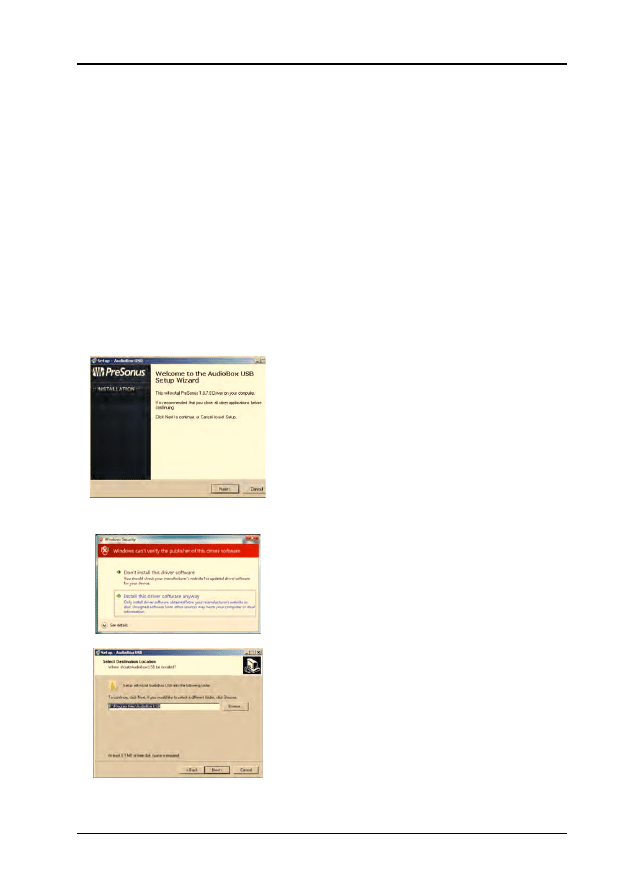
GETTING STARTED
7 | PreSonus 2008
2.1 HARDWARE INSTALLATION
2.1.1 Installation in Mac OS X
The AudioBox USB is a class compliant core audio device. No driver installation is
necessary. Simply connect your AudioBox USB to your computer.
2.1.2 Installation in Microsoft Windows
After inserting the Installation CD into your CDROM drive, the AudioBox USB installer will
take you through each step of the installation process. Please read each message carefully –
ensuring especially you do not connect your AudioBox USB early.
1) The AudioBox USB Installer was written
to be as simple and easytofollow as
possible. Please read each message
carefully to ensure the AudioBox USB is
properly installed.
Before continuing the AudioBox USB
Installation Setup, please close all
multimedia applications and disconnect
your AudioBox USB from your computer.
Once the Welcome screen launches, click
“Next”
2) If you see any Windows Security alerts,
click “Install this driver software
anyway” (Vista) or “Continue anyway”
(XP).
3)
The installer will now show you where the
drivers for your AudioBox USB will be
installed. The installer will automatically
choose the Program Files folder in your
System drive.
Click “Next”
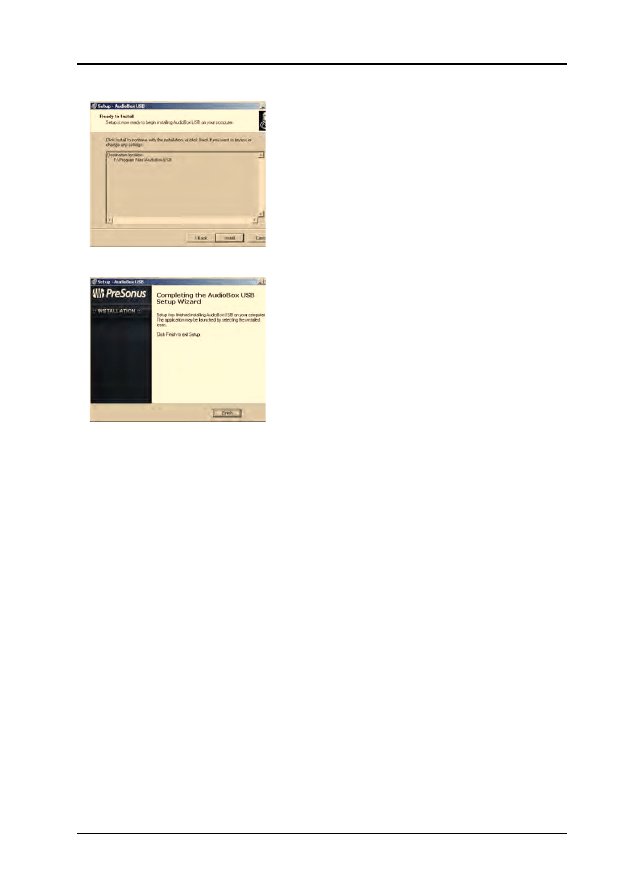
GETTING STARTED
8 | PreSonus 2008
4
) You will now notify you that the driver will
now be installed.
Click “Next”
5)
Congratulations! You have finished
installing your AudioBox USB.
Click “Finish” and connect your
AudioBox USB to your PC.
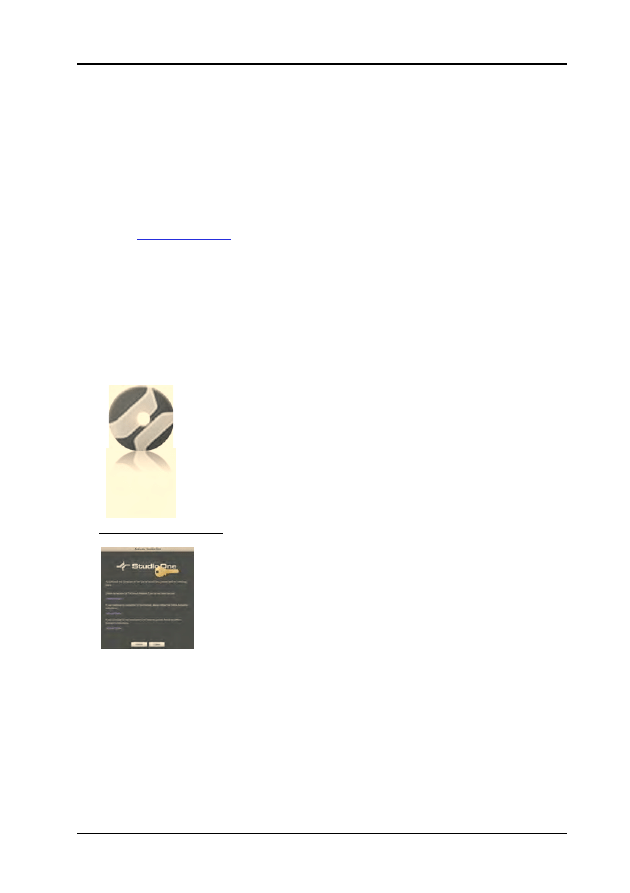
GETTING STARTED
9 | PreSonus 2008
2.2. STUDIO ONE ARTIST
Every PreSonus interface comes complete with Studio One Artist recording software. Whether
you are about to record your first album or your 50
th
, Studio One Artist provides you with all the
tools necessary to capture and mix a great performance. As a valued PreSonus customer, you are
also eligible for an upgrade discount for Studio One Pro when you are ready to master your work,
create a digital version for the Web, or incorporate thirdparty VST plugins into your recording
process. For more details on the Studio One Pro upgrade program for PreSonus customers,
please visit
www.presonus.com
.
Once you have installed your AudioBox USB drivers and connected your interface, you can use
the PreSonus Studio One Artist musicproduction software included with the AudioBox USB to
begin recording, mixing, and producing your music. To install Studio One Artist, insert your
installation disc into your computer’s DVD drive. Follow the onscreen instructions to complete
the installation process.
2.2.1 Installation and Authorization
To Install Studio One Artist, insert your Studio One Artist installation DVD
into your computer’s DVD drive.
PC Users: Launch the Studio One Artist installer and follow the onscreen
instructions.
Mac Users: Simply drag the Studio One Artist application into the
Applications folder on your Macintosh HD.
Creating a User Account
After installing Studio One Artist, launch the program, and the Activate
Studio One menu will appear. If you are a new Studio One user, you
will need to create a user account. Follow the Create Account link if
your computer is connected to the Internet. Once you have created your
account, continue to Activating Studio One Artist Online.
If your computer is not connected to the Internet, visit the Studio One
product page at www.presonus.com on an Internetconnected computer
to create your account. After you have created your account, skip to
Activating Studio One Artist Offline.
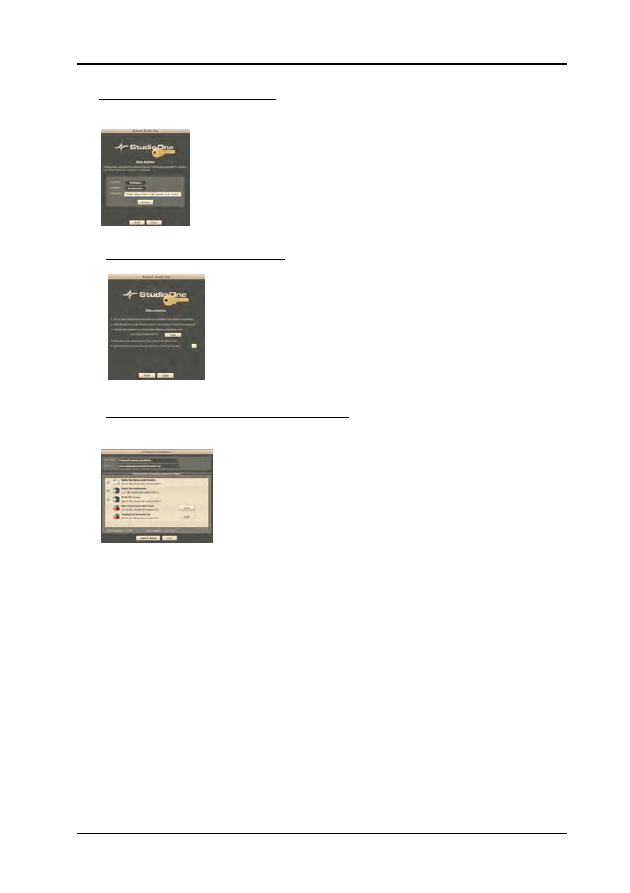
GETTING STARTED
10 | PreSonus 2008
Activating Studio One Artist Online
Now that you have created a user account, you can activate your copy of
Studio One Artist. Launch Studio One Artist, and the Activate Studio
One menu will appear.
Click on the Activate Online link and enter your previously created
account Username, Password, and the Product Key you received with the
Studio One Artist installation disc. Click on the Activate button to finish
the activation process.
Activating Studio One Artist Offline
Once you have created a user account, launch Studio One Artist.
From the Activate Studio One Menu, click on the Activate Offline
link. Follow the instructions to log in to your previously created user
account, register the product, and obtain a license file.
Next, copy the license file to the computer on which Studio One has
been installed, and locate the license file as instructed in the Activate
Studio One menu. The activation process is now complete.
Installing Bundled Content for Studio One Artist
Studio One Artist comes bundled with an array of demo and tutorial
material, sampled instruments, loops, samples, and unique third
party content. The Studio One Artist bundle includes all that you
need to begin producing music.
Upon completing the Studio One Artist installation and activation
process, the Studio One Content Installer will appear. If it does not
appear, navigate to Help/Studio One Installation.
At the top of the installation menu, select the source from which the content will be
installed, as well as the location where you wish to install the content. The source of the
content will be the same DVD from which you installed Studio One Artist. By default,
Studio One Artist will point to your DVD drive as the content source. Listed in the
installation menu are separate entries for each available item. Click in the checkbox next to
each item you wish to install, then click on the Install Packets button at the bottom left of
the menu to install the selected content.
When finished installing content, click on the Done button to exit the menu.
Studio One Artist content can be installed at any time by accessing the Help/Studio One
Installation menu. If you choose not to install any portion of the content, you can install it
at a later time.
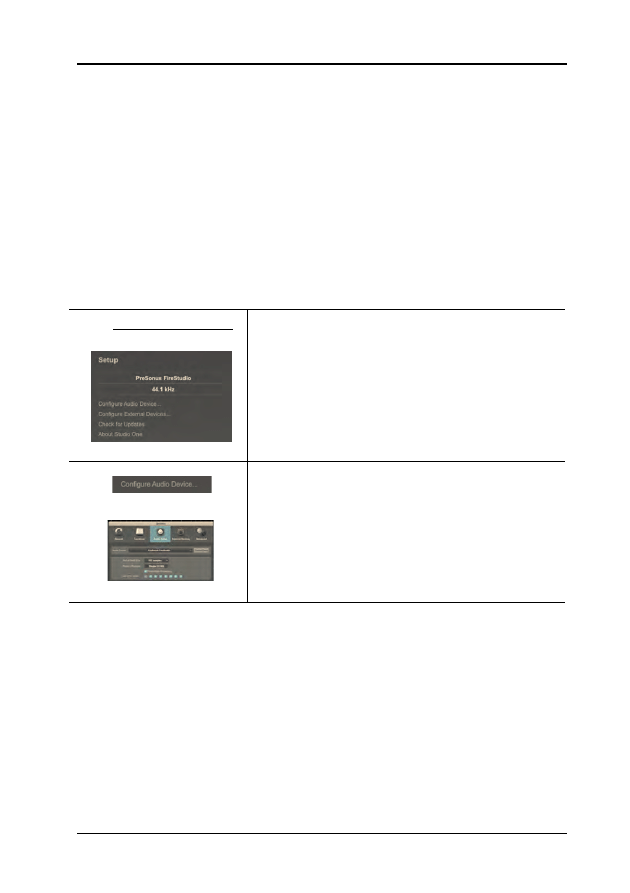
GETTING STARTED
11 | PreSonus 2008
2.2.2 Enabling the Audio Driver
Studio One and Studio One Artist were designed with PreSonus interfaces in mind. Your
AudioBox USB is already integrated into Studio One Artist, so setup is quick and easy. When
Studio One Artist is launched, by default you will be taken to the Start page. On this page,
you will find documentmanagement and deviceconfiguration controls, as well as a
customizable artist profile, a news feed, and links to demos and tutorials from PreSonus. If
you have an Internet connection on your computer, these links will be updated as new
tutorials become available on the PreSonus Web site.
Complete information on all aspects of Studio One Artist is available in the
Reference
Manual
PDF located on the Studio One Artist Installation disc. The information in this
manual covers only the most basic aspects of Studio One Artist and is intended to get you set
up and recording as quickly as possible.
•
Start Page: Setup Area
Shows Active Audio Driver and Sample Rate and Provides
Quick Links to Configure Audio and MIDI
In the middle of the Start page, you will see the Setup area.
Studio One Artist automatically scans your system for all
available drivers and selects a driver. By default, it will
choose a PreSonus driver if one is available.
Selecting a Different Audio Driver From the Start Page
If you do not see your AudioBox USB audio driver on the
Start page when you launch Studio One, click on the
Configure Audio Devices link in the Setup area to open the
Audio Setup Options window.
In the Audio Device menu, select the driver for your
PreSonus interface. Click the Apply button and then OK.
After you have verified that the PreSonus driver has been detected, please continue to the next
Section to set up your external MIDI devices. If you do not have any MIDI devices to connect at
this time, please skip to Section 2.2.4: Configuring Audio I/O.
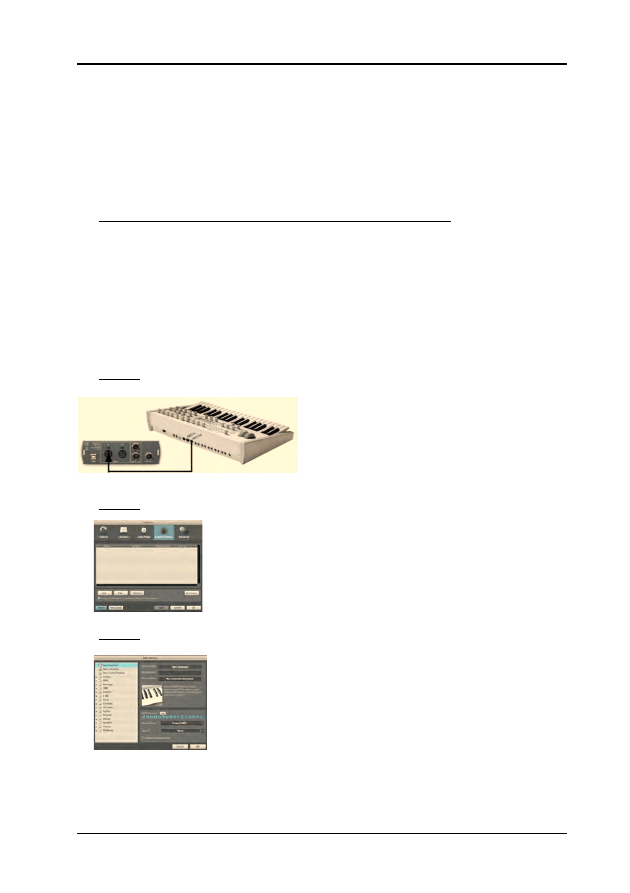
GETTING STARTED
12 | PreSonus 2008
2.2.3 Configuring Your MIDI Devices
From the External Devices window in Studio One Artist, you can configure your MIDI
keyboard controller, sound modules, and control surfaces. This section will take you through
setting up your MIDI keyboard controller and sound module with your AudioBox USB.
Please consult the Reference Manual located on your Studio One Artist installation DVD for
complete setup instructions for other MIDI devices.
Setting up an external MIDI keyboard controller from the Start page.
A MIDI keyboard controller is a hardware device that is generally used for playing and
controlling other MIDI devices, virtual instruments, and software parameters. In Studio One
Artist, these devices are referred to as Keyboards, and they must be configured before they
are available for use. In some cases, your MIDI keyboard controller is also used as a tone
generator. Studio One Artist views the two functions of these types of hardware as two
different devices: a MIDI keyboard controller and a sound module. The MIDI controls
(keyboard, knobs, faders, etc.) will be set up as a Keyboard. The sound module will be set up
as an Instrument.
STEP 1
From the Setup area in the Start page, you can
also set up your external MIDI devices. Before we
set up a new Song for recording, let’s take a
moment to configure external devices. Connect the
MIDI Out of your external MIDI controller to the
MIDI In of your AudioBox USB.
STEP 2
Click on the Configure External Devices link in the Setup area on the
Start page to launch the External Devices window.
Click the Add button.
STEP 3
When the Add Device window launches, select “New Keyboard”
from the menu on the left. At this point, you can customize the name
of your keyboard by entering the manufacturer and device names.
Specify which MIDI channels will be used to communicate with this
keyboard. For most purposes, you should select all MIDI channels. If
you are unsure of which MIDI channels to select, we suggest you
select all 16.
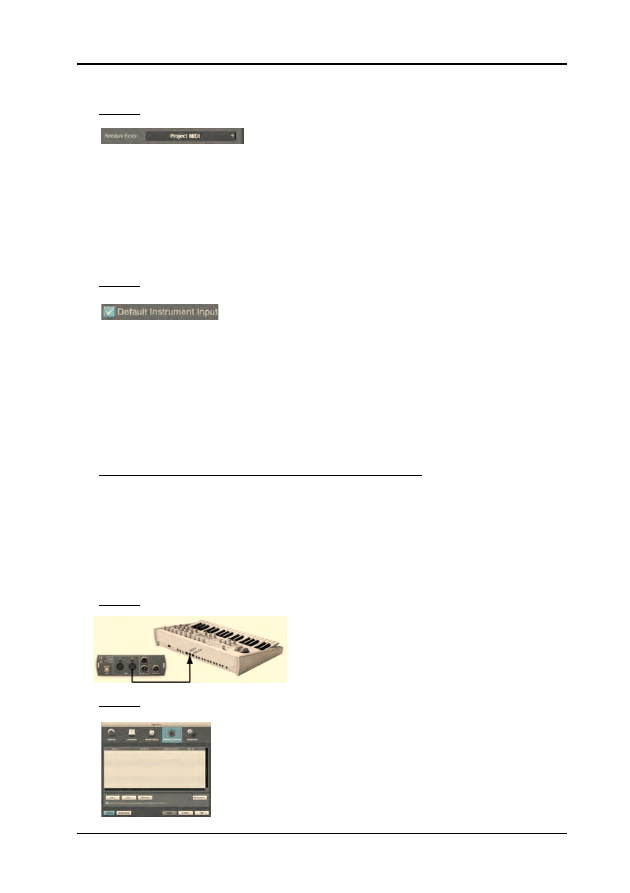
GETTING STARTED
13 | PreSonus 2008
STEP 4
In the Receive From dropdown menu, select the MIDI
interface input from which Studio One Artist will receive
MIDI data. In this case, AudioBox USB.
In the Send To dropdown menu, select the MIDI interface output from which Studio One
Artist will send MIDI data to your keyboard. If your keyboard controller does not need to
receive MIDI data from Studio One (say, for moving motorized faders and the like), you can
leave this unselected. If your keyboard does need to receive MIDI date, you must connect a
MIDI cable from the MIDI output of the MIDI breakout cable to the MIDI input of the
keyboard.
STEP 5
If this is the only keyboard that you will use to control the virtual
instruments and your external synthesizers in Studio One Artist,
you should check the box next to Default Instrument Input. This
will automatically assign your keyboard to control all MIDI
devices in Studio One Artist. When you are finished, click OK.
If you have a sound module you’d like to connect, leave the External Devices window open
and proceed to the next part of this section. If not, you can close this window and skip to
Section 2.2.4: Configuring Your Audio I/O.
Setting up an external MIDI sound module from the Start page:
MIDI instrument controllers (keyboards, MIDI guitars, etc.) send musical information in the
form of MIDI data to tone modules, which respond by generating sound, as instructed. Tone
modules can be standalone sound devices or can be integrated into a controller, as with a
keyboard synthesizer. Studio One Artist refers to all tone generators as Instruments. Once
you have set up your MIDI keyboard controller, take a moment to configure your sound
module.
STEP 1
Connect the MIDI In of your external sound module
to the MIDI Out of your AudioBox USB.
STEP 2
In the External Devices window, click the Add button.
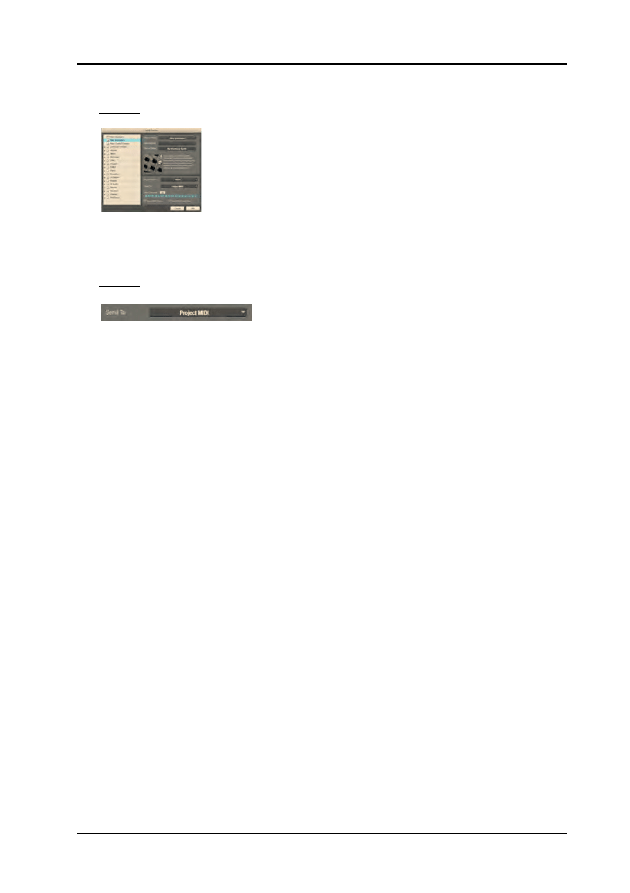
GETTING STARTED
14 | PreSonus 2008
STEP 3
The Add Device window will launch.
From the menu on the left, select “New Instrument.” At this point you
can customize the name of your sound module by entering the
manufacturer and device names.
Specify which MIDI channels will be used to communicate with this keyboard. For most
purposes, you should select all MIDI channels. If you are unsure of which MIDI channels to
select, we suggest you select all 16.
STEP 4
In the Send To dropdown menu, select the MIDIinterface
output from which Studio One Artist will send MIDI data to
your sound module. In this case, AudioBox USB.
In the Receive From dropdown menu, select the MIDIinterface output from which Studio
One Artist will receive MIDI data from your sound module. In most cases, your sound module
will not need to send information to Studio One, so you can leave this unspecified.
Click OK and close the External Devices window. You are now ready to start recording in
Studio One Artist. The remainder of this guide will go over how to set up a Song and will
discuss some general workflow tips for navigating through the Studio One Artist enviroment.
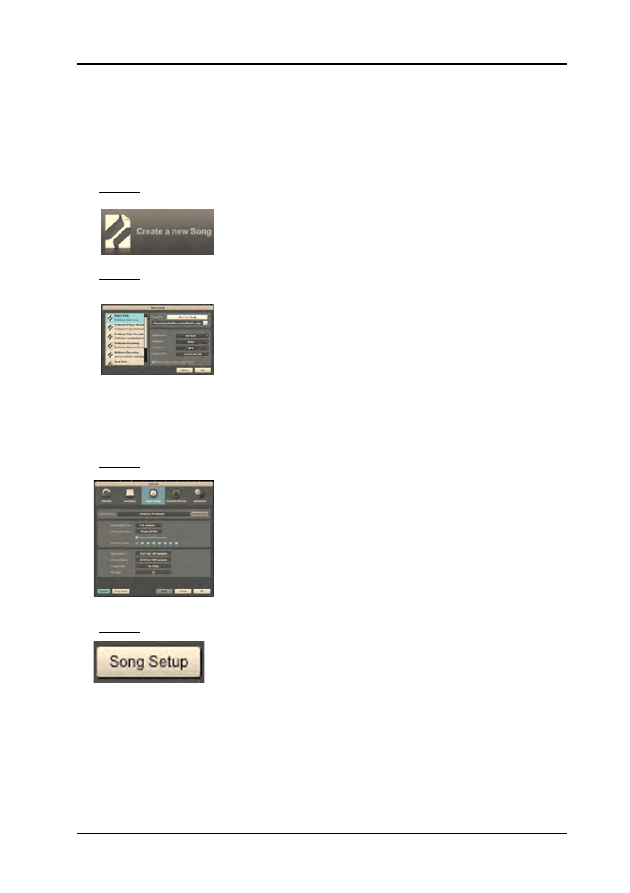
GETTING STARTED
15 | PreSonus 2008
2.2.4 Configuring Audio I/O
Now that you’ve configured your MIDI devices, let’s create a new Song and set up your
default Audio I/O.
STEP 1
From the Start page, select “Create a new Song.”
STEP 2
To begin a new Song, select “Empty Song” from the Templates list.
At this point, you should give your Song a name and select your
preferred sample rate and bit depth. You can also determine the
length of your Song and the type of time format you would like to
use (Notation Bars, Seconds, Samples, or Frames). Click the OK
button when you are finished.
If you plan on importing loops into your Song, you may want to select “Stretch Audio Loops
to Song Tempo” so that any loop of a known BPM (like those in the included content library)
will import at the correct tempo.
STEP 3
When the Song window launches, launch the Audio Setup window
by going to File | Options… (PC) or Studio One | Preferences
(Mac), and click on the Audio Setup button.
STEP 4
Click on the Song Setup button to open the Song Setup window, then
click on the on the Audio I/O Setup icon.
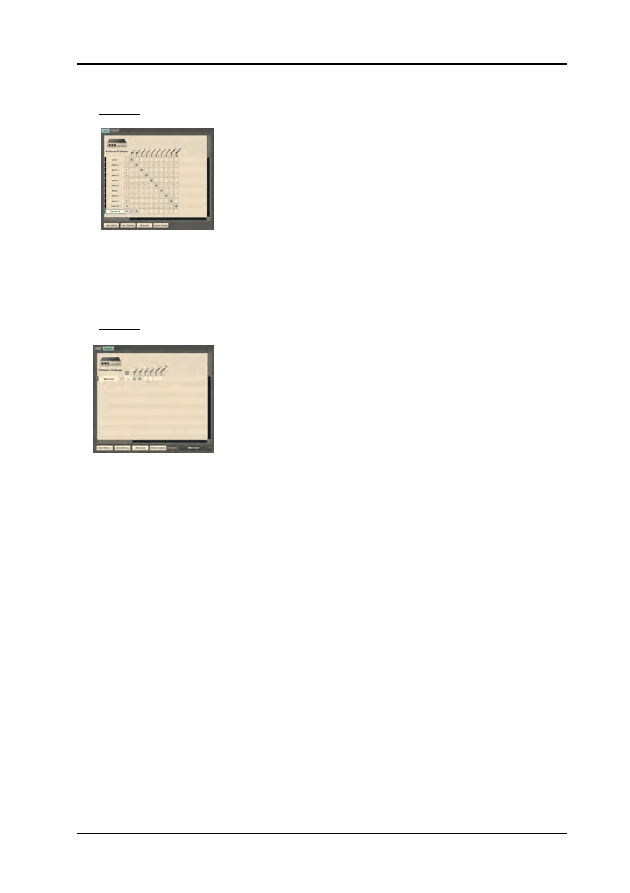
GETTING STARTED
16 | PreSonus 2008
STEP 5
Click on the Inputs tab in the Audio I/O Setup window, and you will
see all of the available inputs on your AudioBox USB. At this time,
you can add the number and type of inputs you plan to use. We
recommend that you create a mono input for both of the inputs on
your AudioBox USB. If you plan on recording in stereo, you should
also create a stereo bus and assign it to the appropriate set of
inputs. You can remove any bus by simply selecting it, then clicking
the remove button. To customize the name of your buses, double
click on the default name to open a text box. When you have
finished typing, hit Enter. If you would like the same inputs to be
available every time you launch Studio One Artist, click the “Make
Default” button.
STEP 6
Click on the Outputs tab, and you will see all of the available
outputs on your AudioBox USB. At this time, you can add the
number of output buses to which you would like to have access and
can give them custom names.
In the lower right corner, you will see the Audition select menu.
This allows you to choose the ouput from which you will audition
audio files prior to importing them into Studio One Artist. In
general, you will want this to be the Main Out bus.
If you would like this output configuration available every time you
launch Studio One Artist, click the Make Default button.
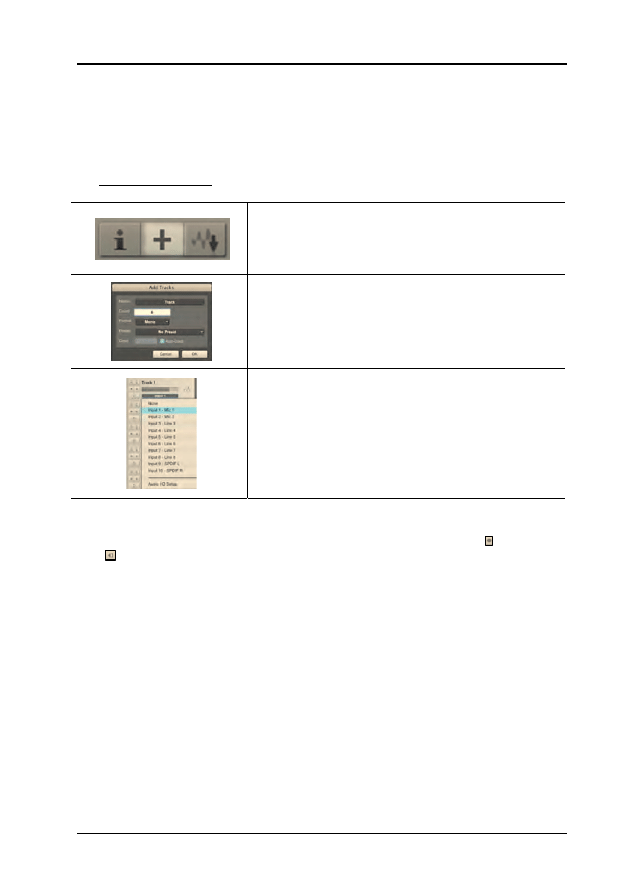
GETTING STARTED
17 | PreSonus 2008
2.2.5 Creating a Song
Now that you’ve configured your MIDI and Audio I/O and created a new Song, let’s go
through some of the basics of Studio One Artist so you can start recording!
Creating Audio Tracks
In the upper left corner of the Arrange window, you will
notice several buttons. The middle button is the Add Tracks
button. Click this button to bring up the Add Tracks
window.
In the Add Tracks window, you can select the number and
type of Tracks you’d like to create (Mono Audio, Stereo
Audio, Instrument, or Automation) and can customize the
name and the color.
Once you have added your Tracks, you can assign the input
by simply clicking on the input to which a Track is currently
assigned. This will bring up your inputs list. You can also
access the Audio I/O Setup from here.
If you would like to add a Track for each of the available
inputs and have the routing automatically assigned, simply
go to Track | Add Tracks for All Inputs.
Too begin recording, create an audio track, assign it to Input 1, and connect a microphone or
instrument to Channel 1 of your AudioBox USB. Select the record enable ( ) and monitor
(
) on your track in Studio One Artist. Turn up the Channel 1 gain knob on your AudioBox
USB while speaking/singing into the microphone or playing your instrument. You should see
the input meter in Studio One Artist react to the input. Adjust the gain so the input level is
near its maximum without clipping.
Turn the Mix knob on the front panel of your AudioBox USB to 12 o’clock. Connect a set of
headphones to your AudioBox’s headphone output. You may also wish to connect monitors to
your interface’s Main Outs. You are now ready to record. For complete instructions, please
consult the Studio One
Reference Manual,
which is located on your Studio One Artist
Installation DVD.
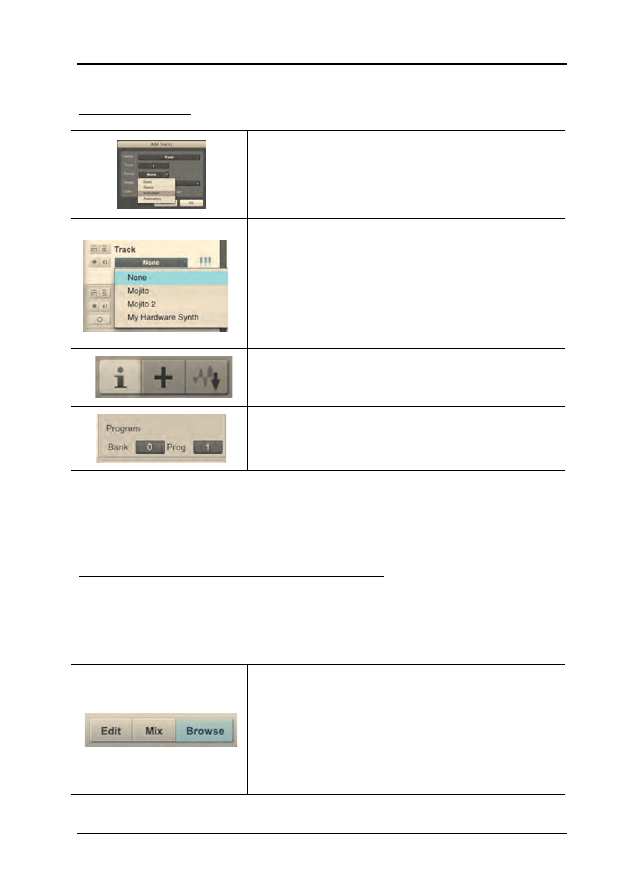
GETTING STARTED
18 | PreSonus 2008
Creating MIDI Tracks
Click on the Add Tracks button. When the Add Tracks
window launches, select Instrument as the Track Format
and click the OK button.
To assign your MIDI input, click on the MIDI Inputs list
and select your external sound module. If you have added
Virtual Inputs to your session, you will also see them as
available inputs.
If you selected your MIDI keyboard controller as the default
keyboard, it will already be selected. If not, choose your
MIDI controller from Output menu directly below.
To the left of the Add Track button, you will find the
Inspector button. Click it to display more parameters for the
selected track.
At the bottom of the Inspector menu, you will see your Bank
and Program selections. From here, you can remotely
change the patch on your sound module
.
Please Note: MIDI data does not contain audio signals. To hear your sound module, you must
connect the audio output of the sound module to an audio input on your interface and your
interfaces’s audio outputs to a sound system. When you are ready to mix your Song, you must
convert the recorded MIDI data to an audio waveform by recording a new audio track
Adding Virtual Instruments and Plugin Effects to your Song
You can add plugins and Instruments to your Song by dragginganddropping from the browser.
You can also drag an effect or group of effects from one channel to another, drag in customized
effects chains, and instantly load your favorite
virtualinstrument patch without ever scrolling
through a menu.
In the lower right corner of the Arrange window are three
buttons. The Edit button opens or closes the Audio editor or
the MIDI pianoroll editor, depending on what type of track
is selected. The Mix button opens and closes the mixer
window. The Browse button opens the Browser window,
which displays all of the available virtual instruments, plug
in effects, audio files, and MIDI files, as well as the pool of
audio files loaded into the current session.
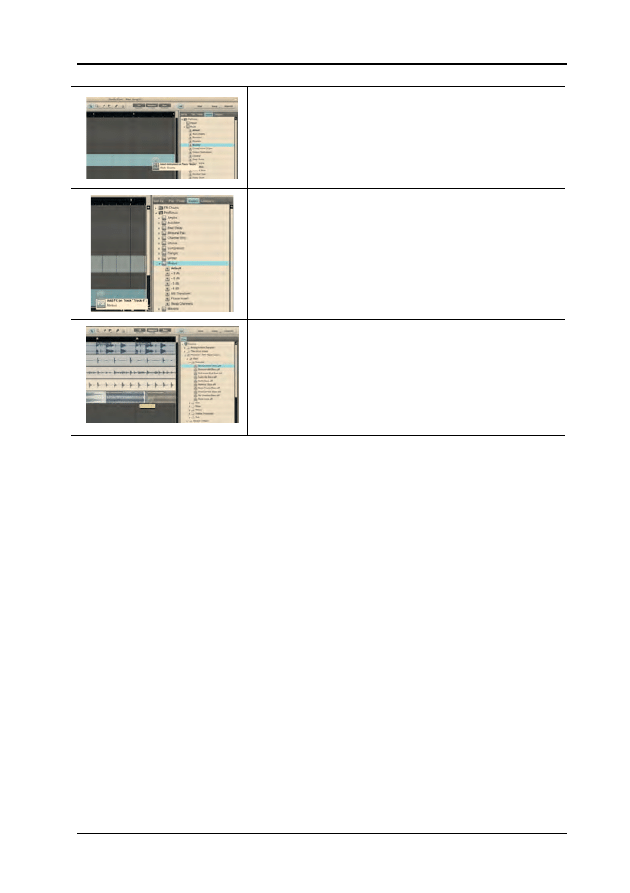
GETTING STARTED
19 | PreSonus 2008
To add a virtual instrument to your session, click the
Browse and Instrument buttons to open the Instrument
Browser. Select the instrument or one of its patches and
drag it into the Arrange view. Studio One Artist will
automatically create a new track and load the Instrument as
the input.
To add a plugin effect to a track, click the Effects button
and select it or one of its presets in the Effects Browser,
then drag it over the track to which you would like to add it.
Audio and MIDI files can also be quickly located,
auditioned, and imported into your Song by dragging them
from the File Browser into the Arrange view. If you drag the
file to an empty space, a new track will be created with that
file placed at the position to which you dragged it. If you
drag the file to an existing track, the file will be placed as a
new part on the track.
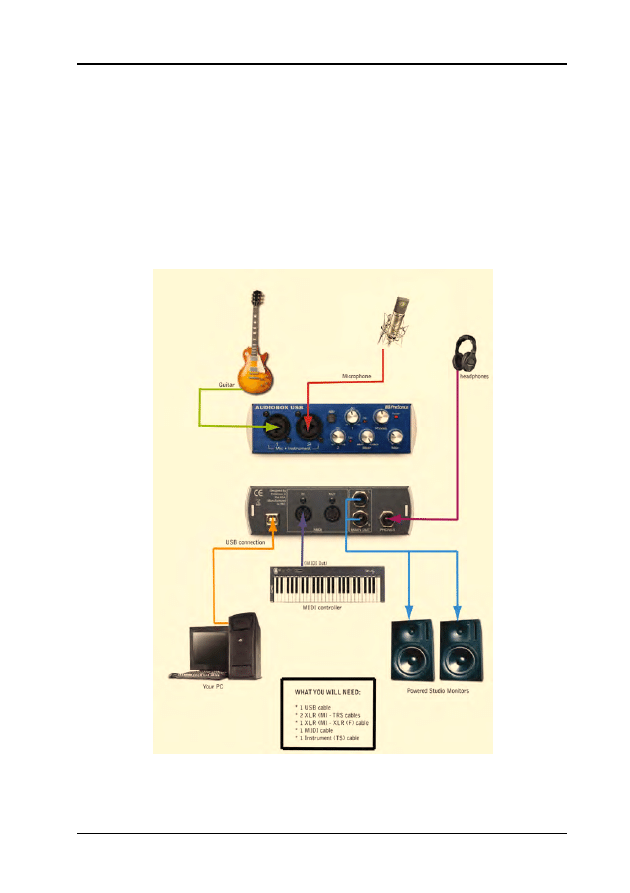
GETTING STARTED
20 | PreSonus 2008
2.3 SAMPLE HOOK UP DIAGRAM
With the AudioBox USB, you can simultaneously record two tracks at one time. Since it is
loaded with two microphone/instrument preamps, you can plug in two microphones to the
AudioBox USB or one microphone and one instrument (i.e. electric guitar, bass, etc). This makes
recording extremely easy. All you need are a couple of microphones, some cables to connect
them, a musician (or two) and the creative energy to bring it all together.
This is a typical singer/songwriter setup. Your needs may vary depending upon the variety of
sources you are recording. Feel free to adapt the sample setup below to your precise needs.

GETTING STARTED
21 | PreSonus 2008
2.4 MICROPHONES
The AudioBox USB works with many microphones including dynamic, ribbon and condenser
microphones.
2.4.1 Condenser
Condenser microphones tend to generate a highquality audio signal and are one of the most
popular mic choices for today’s studio recording applications. Because of their design
technology, condenser microphones require a power source, which can be provided from a
small battery, external power supply or from microphone inputs as
phantom power.
The
AudioBox USB sends phantom power over XLR inputs only.
2.4.2 Dynamic
Dynamic microphones are possibly the most widely used microphone type – especially in live
shows. They are relatively inexpensive, resistant to physical damage and typically handle
high sound pressure levels (SPL) very well. Unlike condenser microphones, dynamic
microphones do not require a power source and, in most cases, has no effect on a dynamic
microphone’s audio quality or sensitivity.
Dynamic microphones, especially ribbon microphones, tend to generate low output voltages,
so they typically need more preamp gain than a condenser microphone.
Ribbon
Ribbon microphones are a special type of dynamic microphone and get their name from the
thin metal ribbon used in their design. Ribbon microphones have very high quality sound
reproduction qualities –
especially higher frequencies sounds. However, they are very fragile
and typically cannot handle high SPL’s.
The most important thing to note about Ribbon microphones is that nearly all
Ribbon
Microphones do NOT require phantom power.
In fact, unless a Ribbon microphone
specifically calls for phantom power, sending
phantom power to a ribbon microphone will
destroy it – usually beyond repair.

GETTING STARTED
22 | PreSonus 2008
2.4.3 USB and other types
There are a vast number of microphone types available, and as technology increases, it is very
likely more will surface. One type of microphone to emerge recently is the USB microphone.
Most USB microphones have their own builtin preamp and use drivers separate from the
AudioBox USB drivers.
If you are using a new or nonstandard type of microphone (i.e., USB, headset, laser,
MEMS, etc.), please consult your microphone’s user’s manual for power requirement or
compatibility information.
Regardless of the microphone type you are using, we recommend reading your microphone’s
user’s manual thoroughly before engaging phantom power or if any other usage questions
arise.
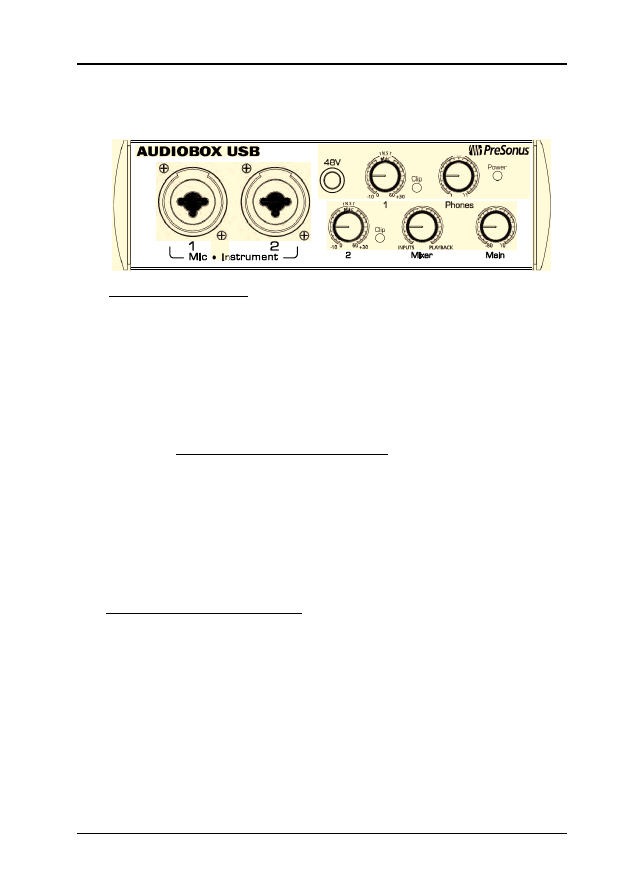
CONTROLS & CONNECTIONS
23 | PreSonus 2008
3.1 FRONT PANEL LAYOUT
•
Microphone PreAmplifier. Your AudioBox USB is equipped with two custom designed
PreSonus microphone preamplifiers for use with all types of microphones including
Dynamics, Condensers and Ribbons as well as instruments and line level signals. The
award winning PreSonus preamplifier design is a Class A input buffer followed by a dual
servo gain stage. This arrangement results in ultra low noise and wide gain control
allowing the AudioBox USB user to boost desirable signal without increasing unwanted
background noise.
o
48 Volt Phantom Power.
The AudioBox USB has 48V Phantom power available for
both mic preamps via a single push button switch on the front panel.
XLR connector wiring for Phantom Power
•
Pin 1 = GND
•
Pin 2 = +48V
•
Pin 3 = +48V
o
Neutrik Combo Connectors.
Both channels of the AudioBox USB have a Mic/Line
connector using the Neutrik Combo connector. This revolutionary style connector lets
you use either ” phone or XLR connectors in the same female input. Both channels of
the AudioBox USB are ” instrument and microphone XLR inputs.
•
Instrument Inputs (Channels 1 and 2). The ” TS connector on channels 1 and 2 are for
use with an instrument (guitar, bass, etc.). When an instrument is plugged into the
instrument input, the mic preamp is bypassed, and the AudioBox USB becomes an active
instrument preamplifier.
NOTE: Active instruments are those that have an
internal preamp
or a
line level output
.
Active instruments should be plugged into a line input rather than into an instrument input.
Plugging a line level source into the instrument inputs on the front of the AudioBox USB
not only risks damage to these inputs but also results in a very loud and often distorted
audio signal.
(In other words, don’t plug a line level source into the combo jacks of channel 1 or 2.)

CONTROLS & CONNECTIONS
24 | PreSonus 2008
•
Input Gain/Trim Control. These knobs provide the following gain structure:
o
XLR Microphone Inputs.
35 dB of variable gain (0 dB to +35 dB)
o
TS ” Instrument/HiZ Inputs.
35 dB of variable gain (0 dB to +35 dB)
•
Clip Indicator. Both channels feature a clip LED next to the trim control. The red clip
indicator LED will illuminate when the channel’s input signal reaches 0 dBFS. At this level,
your mic preamp/line trim signal will exhibit signs of clipping such as distortion. It is highly
recommended you do not allow your converters to clip (the red clip indicators to light up) as
the sound quality will not be desirable.
•
Mixer. The Mixer knob allows you to blend your input signal with the playback stream
from your computer. This allows you to monitor your input signal zerolatency. If the knob
is positioned at 12 o’clock, the input signal and the playback stream will be equally
balanced. Turning the knob towards the left will increase the level of the input signal
relative to the playback stream; turning to the right will increase the level of the playback
stream relative to the input signal.
•
Phones. The Phones knob controls the amount of volume going to the headphone output on
the front of the unit. Notice the volume indicator goes to 11:
use this setting with extreme
caution
.
•
Main. The Main knob controls the output level for the Main Outputs on the back of the
AudioBox USB with a range of 80 db to +4 dB.
•
Power Light. This light indicates the AudioBox USB is receiving bus power.
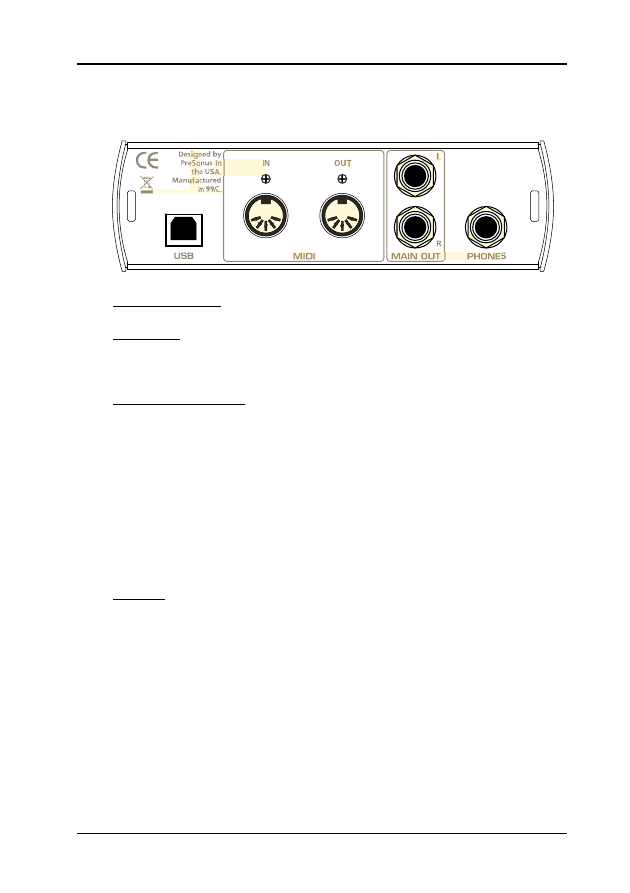
CONTROLS & CONNECTIONS
25 | PreSonus 2008
3.2 BACK PANEL LAYOUT
•
” Headphone Jack. This is where you connect your headphones to the AudioBox USB.
•
Main Output. This is the main output for your AudioBox USB. The output level of the
Main Outputs is controlled by the AudioBox USB Main volume knob on the front of the
unit.
•
MIDI In and Out Ports. MIDI stands for “Musical Instrument Digital Interface”.
However, the MIDI standard goes well beyond just instrumentation and sequencing. The
MIDI inputs and outputs allow connection and/or communication with external MIDI
equipment. One function of this port is MIDI programming. These can also be used for
MMC (MIDI Machine Control) and MTC (MIDI Time Code).
NOTE: MIDI is not audio but is frequently used to trigger or control an audio source
(such as a VST plugin or synthesizer). When using MIDI, ensure your MIDI data
is correctly sent and received by the appropriate hardware or software
instruments. You may also need to return those devices’ audio to the AudioBox
USB. Please consult the User’s Manual of your MIDI devices for help with MIDI
setup and usage.
•
USB port. This is where you connect the USB cable from your AudioBox USB to your
computer. The AudioBox is completely bus powered from this connection.

TECHNICAL SPECIFICATIONS
26 | PreSonus 2008
4.1 SPECIFICATIONS
Microphone Preamp
Type ............................................................................................................XLR Female Balanced
Frequency Response (±3.0 dB) ............................................................................. 14 Hz to 70 kHz
Input Impedance (Balanced) ..............................................................................................1200
THD+N (unwtd, 1 kHz @ +4 dBu Output, Unity Gain) ................................................... < 0.008%
EIN (Aweighted, 55dB Gain, 150 Input, 20Hz to 22 kHz) ......................................... 115 dBu
S/N Ratio (Unity Gain, Ref. = +4 dBu, 20Hz to 22 kHz) ................................................... > 95 dB
Common Mode Rejection Ratio (1 kHz, 55 dB Gain) ......................................................... > 45 dB
Gain Control Range (± 1dB) .................................................................................... 0 dB to 35 dB
Max Input Level (Unity Gain, 1 kHz @ 0.5% THD+N) ....................................................... 3 dBu
Phantom Power (±2 VDC) ............................................................................................. +48 VDC
Instrument Input
Type ....................................................................................................................................... ”
TRS Female Unbalanced Input Impedance ........................................................................ 0.5 M
Line Outputs
Type ................................................................................................................................” TRS
Balanced Output Impedance ..................................................................................................51
Headphone Output
Type ...........................................................................................................” TRS Active Stereo
Maximum Output .................................................................................... 60 mW/Ch @ 60 Load
Frequency Response (±1.0 dB) ............................................................................. 20 Hz – 30 kHz
MIDI I/O
Type ......................................................................................................... Dual 5pin Female DIN
Digital Audio
ADC Dynamic Range (Awtd, 48 kHz Sample Rate) ............................................................ 102 dB
DAC Dynamic Range (Awtd, 48 kHz Sample Rate) ............................................................ 110 dB
Bit Depth ................................................................................................................................. 24
Reference Level for 0dBFS ................................................................................................ +4 dBu
Internal Sample Frequency Selections (kHz) .................................................................... 44.1, 48
A s a c o m m i t m e n t t o c o n s t a n t i m p r o v e m e n t , P r e S o n u s A u d i o E l e c t r o n i c s , I n c .
r e s e r v e s t h e r i g h t t o c h a n g e a n y s p e c i f i c a t i o n s t a t e d h e r e i n a t a n y t i m e
w i t h o u t n o t i f i c a t i o n .
Wyszukiwarka
Podobne podstrony:
AudioBox USB Manual
USB driver install manual
11 po PowerMust 1 2K USB User Manual
manual usb strage mode
usb to can comp manual
J750 USB Downloader Manual for English
USB TO RS232 Cable for Windows 2000 user s manual
USB TO RS232 Cable for Windows 2000(Chinese) user s manual
USB ORZECH
usb
Porównanie USB FireWire
4 USB 2
PANsound manual
als manual RZ5IUSXZX237ENPGWFIN Nieznany
hplj 5p 6p service manual vhnlwmi5rxab6ao6bivsrdhllvztpnnomgxi2ma vhnlwmi5rxab6ao6bivsrdhllvztpnnomg
BSAVA Manual of Rabbit Surgery Dentistry and Imaging
Okidata Okipage 14e Parts Manual
więcej podobnych podstron